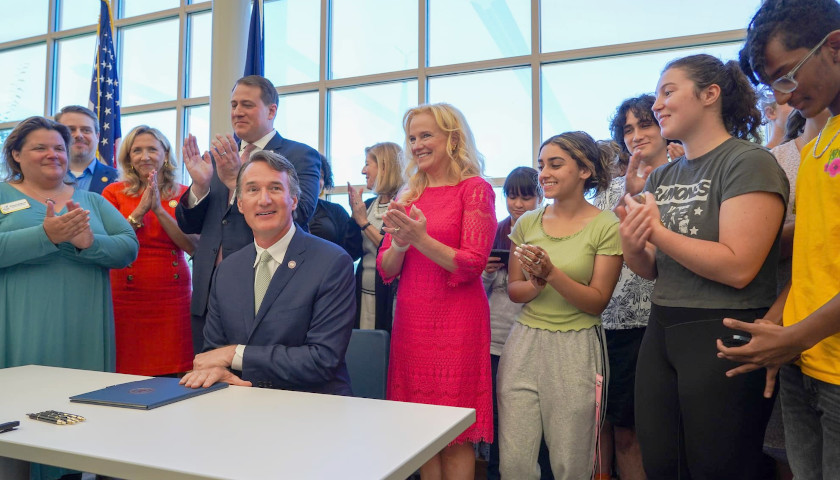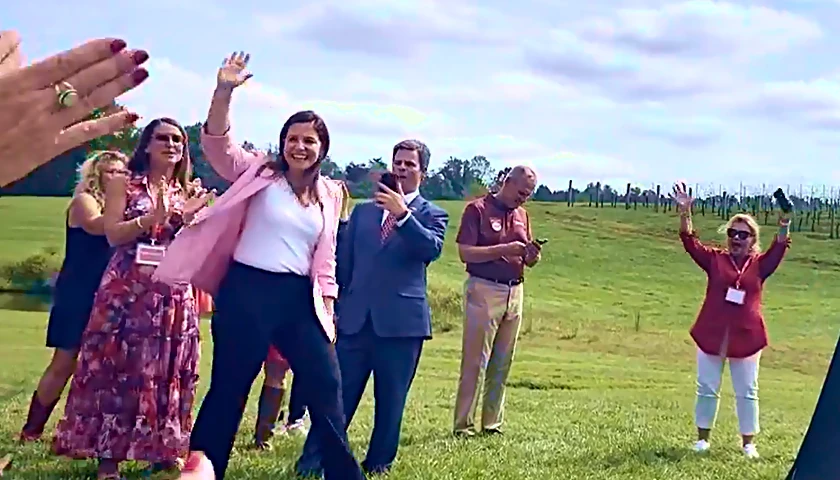Governor Glenn Youngkin signed his third executive directive as part of an announcement of his administration’s efforts to address teacher shortages; at the same event in Stafford County, Secretary of Education Aimee Guidera announced the Bridging the Gap Initiative, aimed at addressing learning losses.
“So when we have a shortage of teachers and we’re trying to bridge the gap, we’ve got to work extra hard in order to close the gap of teachers as well,” Youngkin said, emphasizing the importance of in-person learning within the context of learning losses.
Youngkin highlighted raises and bonuses for teachers in Virginia’s recently-passed budget, but said there’s more to do. He said his executive directive will facilitate allowing former teachers to return to the field, directs Superintendent of Public Education Jillian Balow to make it easier for people with qualifications to enter the field. He said the directive also aims at a partnership between the Department of Education and the Department of Labor so that education students can apprentice in classrooms, helping new teachers enter the workforce, but also helping address current personnel shortages by putting apprentices in the classroom.
Youngkin said the directive includes recruitment and retention programs targeted at communities with the most need, and will start a data analysis program to determine why teachers are leaving the field.
“Finally, one of the areas that we already know that teachers find most difficult is balance, the balance across the huge demands that are placed upon them, and the fact that they have lives too,” Youngkin said. “And so at the top of the list is childcare and early education.”
He said that early childhood educators are “the workforce that supports the workforce.”
“Parents and teachers matter,” Youngkin said in a press release. “This directive is a comprehensive approach with multiple solutions to ensuring every student has a great teacher in the classroom.”
In a press release, the Virginia Education Association President Dr. James Fedderman said, “While Governor Youngkin’s Executive Directive today certainly has some ideas we can support, it doesn’t offer the type of serious investments that can really move the needle on this issue.”
Fedderman called for more localities to enact collective bargaining for educators, competitive salaries for educators, additional aid to high-poverty schools, lifting the “support cap” on state aid for school positions, investing in community school models, and fully funding the Virginia Board of Education’s Standards of Quality.
The association president said, “Our current budget surplus could be used effectively to solve this problem, which affects all Virginia’s citizens. By what he decides to do with those funds, our governor will show us if he truly values education and solving our teacher shortages.”
Bridging the Gap Initiative
In the press release, the Youngkin administration said the initiative is a partnership with 15 pilot school divisions. In remarks, Secretary Guidera said the initiative is done in a spirit of new hope and new opportunities, and described the conclusions of a recent round table meeting. She said the initiative needs to be a team effort, but emphasized another conclusion from the meeting.
“What we want is data to be the beginning of a conversation where we’re changing conversations, we’re changing decisions, we’re changing actions, and most importantly, we’re changing results and we’re changing lives,” said Guidera, who has a background in using data to improve school quality.
“Three components of Bridging the Gap: One, we are going to make sure that data is presented in a way to parents, teachers, and students that they don’t have to work at midnight to figure out what the data says,” she said.
“Second piece, we are going to make sure that our teachers know how to have the card conversation with parents and the students when students when students are not on success,” Guidera said.
“And lastly, this is about creating personalized learning plans for every child in K-eight who is further behind than they need to be and to figure out how do we use that information, how do we use evidence to make sure that we are seeing every child and providing that personalized education and intervention to get that child on track.”
– – –
Eric Burk is a reporter at The Virginia Star and The Star News Network. Email tips to [email protected].
Photo “Glenn Youngkin” by Glenn Youngkin.





